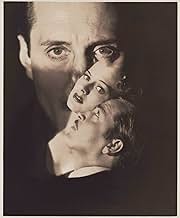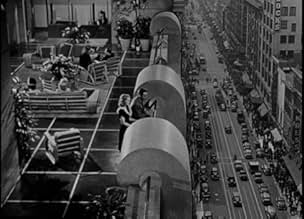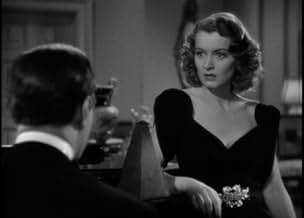CALIFICACIÓN DE IMDb
6.6/10
374
TU CALIFICACIÓN
Un médico loco se casa con una mujer adinerada y, con la ayuda de su demente asistente, la asesina por su dinero.Un médico loco se casa con una mujer adinerada y, con la ayuda de su demente asistente, la asesina por su dinero.Un médico loco se casa con una mujer adinerada y, con la ayuda de su demente asistente, la asesina por su dinero.
- Dirección
- Guionista
- Elenco
Barbara Jo Allen
- Louise Watkins
- (as Barbara Allen [Vera Vague])
Bobby Barber
- Bald Man in Library
- (sin créditos)
William 'Billy' Benedict
- Mickey Barnes - Copy Boy
- (sin créditos)
George Chandler
- Elevator Operator
- (sin créditos)
Edward Earle
- Librarian
- (sin créditos)
Chuck Hamilton
- Police Officer at Train Station
- (sin créditos)
Sam Harris
- Passerby
- (sin créditos)
Harry Hayden
- Ticket Clerk
- (sin créditos)
Douglas Kennedy
- Hotel Clerk
- (sin créditos)
Settar Körmükçü
- Dr. David Profesor
- (sin créditos)
John Laing
- Intern
- (sin créditos)
- Dirección
- Guionista
- Todo el elenco y el equipo
- Producción, taquilla y más en IMDbPro
Opiniones destacadas
"Oh, there's no such thing as sanity. At it's best a heroic and precarious little hiding place in which we try to conceal ourselves from the devils...The devils of time, space, things unknown, and the past."
Although its title suggests conventional horror, "The Mad Doctor" is a pitch black thriller with some with some truly harrowing subject matter. Basil Rathbone plays Dr. Sebastien, a Bluebeard-like psychiatrist who recently killed off his wealthy wife Ida. After arousing the suspicion of local doctor Ralph Morgan, Rathbone leaves town. He soon finds his next mark, a deeply troubled young socialite named Linda that's been suffering with suicidal ideations.
Rathbone is accompanied in his efforts by Martin Kosleck as Maurice, a sort of male secretary. After seeing these two interact, it becomes very clear that they are more than criminal accomplices. When we see Kosleck in Rathbone's home or office, he's variously arranging flowers, spritzing himself with cologne, fussing with Rathbone over a choice of tie, and languorously sketching a black cat while wearing a bathrobe. When Rathbone starts to become genuinely interested in Linda, Kosleck responds with wounded jealousy.
This is very obviously a coded gay relationship, years ahead of the one in Hitchcock's "Rope." The scenes between Rathbone and Kosleck, both superb actors, positively crackle. In one scene, Rathbone gives a bone chilling monologue describing his contempt for dead wife Ida: "These atrocious paintings. This absurd wallpaper. These pathetic antiques. They all breathe her spirit. I can almost see her now coming down those stairs with that foolish smile and the love light in her eyes. I can never forgive her the eight months spent in this cave of romance."
The danger and intensity only ratchet up from there, climaxing in a truly haunting and beautifully executed ending. This is one of Basil Rathbone's most underrated films.
Although its title suggests conventional horror, "The Mad Doctor" is a pitch black thriller with some with some truly harrowing subject matter. Basil Rathbone plays Dr. Sebastien, a Bluebeard-like psychiatrist who recently killed off his wealthy wife Ida. After arousing the suspicion of local doctor Ralph Morgan, Rathbone leaves town. He soon finds his next mark, a deeply troubled young socialite named Linda that's been suffering with suicidal ideations.
Rathbone is accompanied in his efforts by Martin Kosleck as Maurice, a sort of male secretary. After seeing these two interact, it becomes very clear that they are more than criminal accomplices. When we see Kosleck in Rathbone's home or office, he's variously arranging flowers, spritzing himself with cologne, fussing with Rathbone over a choice of tie, and languorously sketching a black cat while wearing a bathrobe. When Rathbone starts to become genuinely interested in Linda, Kosleck responds with wounded jealousy.
This is very obviously a coded gay relationship, years ahead of the one in Hitchcock's "Rope." The scenes between Rathbone and Kosleck, both superb actors, positively crackle. In one scene, Rathbone gives a bone chilling monologue describing his contempt for dead wife Ida: "These atrocious paintings. This absurd wallpaper. These pathetic antiques. They all breathe her spirit. I can almost see her now coming down those stairs with that foolish smile and the love light in her eyes. I can never forgive her the eight months spent in this cave of romance."
The danger and intensity only ratchet up from there, climaxing in a truly haunting and beautifully executed ending. This is one of Basil Rathbone's most underrated films.
This Unusual Film "Forecasts" an Anticipation of a Sub-Genre of Film-Noir. The Mental-Health Field...
It was Perhaps, the Dark Genre Most Go-To Subject-Matter with Psychiatry and the Many Unknowns and Rife with Controversy.
To Diagnosis Apart from the Usual Scientific Method that Resulted in "Evidence" from the Material-World.
The Methods Used in the Dual Practices of "Health-Care" were Mostly Diametrically Opposed in the Historical-Record. But with Sigmund Freud and His Peers Bringing the Field into Close Proximity "Hard-Science".
Treating Suffering Patients Needs, by Qualified Practitioners, Should be Taken Seriously. Not Dismissed and Ridiculed.
In 1940, the "Mad" in the Title Makes the Movie Sound Like a "Horror Movie". But, This Film Never Stray from its Roots of "Thriller",
It Explores Very-Dark, Complex Behavior.
Basil Rathbone Creating Charm, a Suave Demeanor, with a Confident Delivery of His "Svengali-Like" Power,
Dreamy-Eyed Ellen Drew is Overwhelmed by a Childhood Death or Her Father, by Suicide with Ensuing Nightmares.
She is Fine as a Victim of Trauma, and Handles the Complexity with an Essential Performance.
Another Reason this Forgotten Film is Required Viewing...
A Quirky Element that was Extremely Rare and Almost Non-Existent in "The Code" Years. An In-Your-Face Gay Couple. The Movie Doesn't Try and Hide it, although it Never Verbally Reveals it, but it's On-Screen with a Multitude of Stereo-Typical Behavior by Rathbone and His Companion.
It's On-Screen for Every-One from the Trailer-Park to the Penthouse to Understand. It's there, No Subtlety.
"The Mad Doctor" is a Hidden-Gem...
Wildly Unknown, and a Treat for Film-Fans that Love Discovering and Appreciating Movies that have a Certain Anti-Routine Approach and Takes Chances...
Willing to Create Outside Conventional Attitudes and Expectations in the World of "The Most Popular Art-Form of the 20th Century".
It was Perhaps, the Dark Genre Most Go-To Subject-Matter with Psychiatry and the Many Unknowns and Rife with Controversy.
To Diagnosis Apart from the Usual Scientific Method that Resulted in "Evidence" from the Material-World.
The Methods Used in the Dual Practices of "Health-Care" were Mostly Diametrically Opposed in the Historical-Record. But with Sigmund Freud and His Peers Bringing the Field into Close Proximity "Hard-Science".
Treating Suffering Patients Needs, by Qualified Practitioners, Should be Taken Seriously. Not Dismissed and Ridiculed.
In 1940, the "Mad" in the Title Makes the Movie Sound Like a "Horror Movie". But, This Film Never Stray from its Roots of "Thriller",
It Explores Very-Dark, Complex Behavior.
Basil Rathbone Creating Charm, a Suave Demeanor, with a Confident Delivery of His "Svengali-Like" Power,
Dreamy-Eyed Ellen Drew is Overwhelmed by a Childhood Death or Her Father, by Suicide with Ensuing Nightmares.
She is Fine as a Victim of Trauma, and Handles the Complexity with an Essential Performance.
Another Reason this Forgotten Film is Required Viewing...
A Quirky Element that was Extremely Rare and Almost Non-Existent in "The Code" Years. An In-Your-Face Gay Couple. The Movie Doesn't Try and Hide it, although it Never Verbally Reveals it, but it's On-Screen with a Multitude of Stereo-Typical Behavior by Rathbone and His Companion.
It's On-Screen for Every-One from the Trailer-Park to the Penthouse to Understand. It's there, No Subtlety.
"The Mad Doctor" is a Hidden-Gem...
Wildly Unknown, and a Treat for Film-Fans that Love Discovering and Appreciating Movies that have a Certain Anti-Routine Approach and Takes Chances...
Willing to Create Outside Conventional Attitudes and Expectations in the World of "The Most Popular Art-Form of the 20th Century".
I remember seeing THE MAD DOCTOR on TV back in the early 1960s and although I didn't see it again until the release of this Blu-Ray half a century later, parts of it, especially the ending, had remained with me. Why this film has not made its bow on home video until now is beyond me. It's an A Movie, as can be seen by the big budget, but with B Movie sensibilities regarding its use of character players outside of Rathbone and its overall Film Noir look which is due to cinematographer Ted Tetzlaff. Even the title sounds like a B Movie. However the strongest element in the whole mix is the screenplay. More about that later.
The plot concerns a suave Svengali-like psychiatrist played by Rathbone who marries wealthy women and then disposes of them. He meets a wealthy socialite who has suicidal tendencies (Ellen Drew) and plans to make her his next victim. Can her reporter boyfriend (John Howard), whom she has rejected, save her in time? Nothing out of the ordinary there. What IS different in THE MAD DOCTOR is the relationship between Rathbone and his constant companion played by Martin Kosleck. It is clearly a gay relationship in everything but name and how it got past the 1940 censors is a question worth asking.
The screenplay was originally written by top writers Ben Hecht & Charles MacArthur in the early 1930s and intended for John Barrymore (hence the Svengali angle). It was originally called "The Monster" and later "Destiny". That explains the quality dialogue which is one of the movie's highlights. When Barrymore bowed out, the script sat on the shelf for 5 years before Paramount used it. They had changes made by Howard W. Green who received sole screen credit. Although full of dark moments, there is a lightness of touch from director Tim Whelan which adds to the enjoyment. Kino deserves credit for resurrecting this forgotten gem. Once you see it, you'll wonder why it stayed hidden for so long...For more reviews visit The Capsule Critic.
The plot concerns a suave Svengali-like psychiatrist played by Rathbone who marries wealthy women and then disposes of them. He meets a wealthy socialite who has suicidal tendencies (Ellen Drew) and plans to make her his next victim. Can her reporter boyfriend (John Howard), whom she has rejected, save her in time? Nothing out of the ordinary there. What IS different in THE MAD DOCTOR is the relationship between Rathbone and his constant companion played by Martin Kosleck. It is clearly a gay relationship in everything but name and how it got past the 1940 censors is a question worth asking.
The screenplay was originally written by top writers Ben Hecht & Charles MacArthur in the early 1930s and intended for John Barrymore (hence the Svengali angle). It was originally called "The Monster" and later "Destiny". That explains the quality dialogue which is one of the movie's highlights. When Barrymore bowed out, the script sat on the shelf for 5 years before Paramount used it. They had changes made by Howard W. Green who received sole screen credit. Although full of dark moments, there is a lightness of touch from director Tim Whelan which adds to the enjoyment. Kino deserves credit for resurrecting this forgotten gem. Once you see it, you'll wonder why it stayed hidden for so long...For more reviews visit The Capsule Critic.
Strangely lacklustre reviews to this quite novel 1940 Noir. Insightful, knowledgeable scripting, wonderful schwartz photography from Ted Tetzlaff. A sinister Rathbone undulating between predator and smitten, with both his male accomplice and the full lips of Ellen Drew on the way to more resolute acting ahead. The opening 10 minute rainstorm introduces the maelstrom perfectly and it continues at a good pace, with a variety of well edited sequences adding to the narrative flow, the high night time shots above 5th Avenue conjured well by subtle SFX. The ubiquitous Ben Hecht had a hand in the screenplay, alongside Harold J. Green, and it shows in this robust, ballsy psycho-drama.
Quite a few reviews here have mentioned the ' relationship ' between Basil Rathbone's character and Martin Kosleck's character as being coded homosexuals. I thoroughly endorse this as I watched this film quite by accident on YouTube and I was surprised to see just how intimate in speech and gesture this couple were. The fact that they were both killers and that women had been murdered for their rich lifestyle reminded me of other homosexual killers in both ' Rope ' and ' Compulsion. ' and how somehow they got certificates in the UK admitting children with adults to see them. In the UK the film was called ' A Date with Destiny ' and not the horror signifier of ' The Mad Doctor ' which would have called out for an H certificate for adults only. Rathbone believes he has been saved from evil by falling in love with his last prospective victim, and his male partner, quite rightly becomes as righteously cross as an abandoned ' wife ' or ' husband. ' A Queer film indeed which has not as far as I can tell by historians of Queer and Gay cinema been noticed. America has been fiercely aggressive towards positive gay endings, even to today so any representation on screen of a possible gay character or two in a partner relationship has had to follow the tropes of abandonment, death or imprisonment. For a gay audience these negatives had to be also positives simply because homosexuality was overtly or implicitly seen on the screen. I could take a swipe at a few recent examples but I will concentrate on this 1941 film. Tim Whelan directs it well in Film Noir mode, and there are outstanding shots of New York during this period. The editing excellent and the acting exceptionally good, Ellen Drew as the last potential victim is perfect, shading her role from black mood to light laughter with professional expertise. I must mention Barbara Jo Allen as a friend who has a lot of great lines, delivered to perfection. A definite Paramount Eve Arden, lightening the film whenever she is in a scene. To sum up a taut thriller with touches of horror this deserves in my opinion a ten. A vastly underrated film on all levels. One final observation: the BBFC was very reluctant to give out H certificates during WW2, so that may explain the change of the film's title.
¿Sabías que…?
- TriviaOne of over 700 Paramount Productions, filmed between 1929 and 1949, which were sold to MCA/Universal in 1958 for television distribution, and have been owned and controlled by Universal ever since; its earliest documented telecast took place in Seattle Monday 11 May 1959 on KIRO (Channel 7).
- Citas
Maurice Gretz: You're like all the other clever ones, clever until they meet a woman, and then they suddenly become fools.
- ConexionesReferenced in Svengoolie: Night Monster (2015)
- Bandas sonorasAloha 'Oe
Music by Queen Liliuokalani
Selecciones populares
Inicia sesión para calificar y agrega a la lista de videos para obtener recomendaciones personalizadas
- How long is The Mad Doctor?Con tecnología de Alexa
Detalles
- Fecha de lanzamiento
- País de origen
- Idioma
- También se conoce como
- The Mad Doctor
- Locaciones de filmación
- Productora
- Ver más créditos de la compañía en IMDbPro
- Tiempo de ejecución1 hora 30 minutos
- Color
- Relación de aspecto
- 1.37 : 1
Contribuir a esta página
Sugiere una edición o agrega el contenido que falta

Principales brechas de datos
By what name was La cita fatal (1940) officially released in India in English?
Responda


































